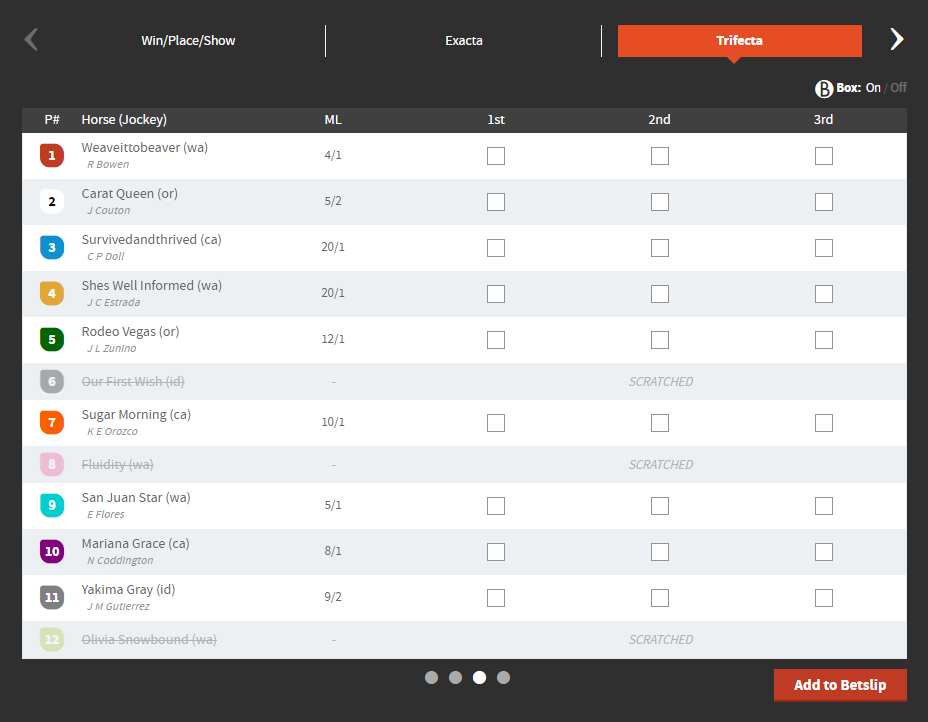Guide to Trifecta Betting
Anyone who bets on horse racing should know how to place a trifecta. Although this type of wager is hard to get right, trifecta betting has the potential to be very profitable. It’s one of the best ways to win big without putting a lot of money at risk.
A typical trifecta costs just $2, and the returns can be enormous. When longshot Giacomo won the 2005 Kentucky Derby, for example, the trifecta payout was an incredible $133,134.80. There aren’t many other ways to win that kind of money from such a small stake.
Trifecta payouts aren’t ALWAYS that big, of course. The average payout at the Kentucky Derby is around $7,000, and the average payout across all races is a lot lower than that. Remember, though, this wager only costs $2. Even when the payout is “only” a few hundred dollars, that’s still a great return for such a small stake.
It’s no surprise, then, that trifecta betting is popular with both casual bettors and serious handicappers.
A lot of bettors don’t really understand trifectas, though. We’re often asked to explain them by people who are new to horse racing betting and even by some people who have been betting for years. That’s why we’ve written this page where we answer all the important questions about trifecta betting.
How We Rate

Safety & Security
You should be able to gamble online without fear. So we only recommend licensed sites that use the latest security and encryption techniques.

Bonuses
Maximize your bankroll with fantastic bonuses. Our recommended sites offer valuable bonuses with fair terms and conditions, including manageable wagering requirements.

Games & Betting
The best sites have the best wagering options. That’s why you will find extensive games and betting opportunities on our recommended sites.

Banking
Getting your money to and from your account shouldn’t be a hassle. We only recommend sites with a variety of convenient banking methods, including cryptocurrency and e-wallets.
What Is a Horse Racing Trifecta?
A horse racing trifecta is an exotic wager on which horses will finish in the first three positions in a race. To win a trifecta, you have to pick the right three horses and also their exact finishing positions. If you don’t get all three horses correct or if you get the finishing order wrong, you win nothing. This is not an easy wager to get right, which is why the payouts are so high compared to the stake.
Trifectas are also known as triactors or tricasts. The “standard” cost of this wager is $2, but for most races, there are reduced cost options. You’re usually able to stake just $1 per wager if you prefer, and often as low as $.50. Of course, potential payouts are reduced accordingly.
We explain exactly how trifecta payouts are calculated further down this page. Before we get to that, we’ve explained how the various types of trifecta work. This is vital information if you want to fully understand trifecta betting.
What Are the Different Types of Trifecta?
There are three different types of trifecta wagers. These are as follows.
- Straight trifecta
- Trifecta box
- Trifecta wheel
Let’s take a look at how each of these types works.
Straight Trifecta
This is the simplest type of trifecta. It’s a single wager where you pick exactly three horses and decide the exact order you think they will finish in. Here’s an example.
You pick the #4 horse to win, the #3 horse to come second, and the #1 horse to come third. The horses MUST finish 4-3-1 for you to win. If they finish 4-1-3, you’re close but not close enough. You’ll not get a return on your wager.
The other types of trifectas are a little more forgiving, as you don’t technically have to predict the exact finishing order. There is a tradeoff, though, as you’ll find out.
Trifecta Box
A trifecta box can also be known as a reverse triactor or a combination tricast. It’s easier to win than a straight trifecta, but it comes at a cost. It’s basically a multiple wager that includes ALL possible finishing orders of your chosen horses.
Instead of backing the single finishing order of 4-3-1 as per the above example, if you chose the same three horses, you’d be backing all of the following finishing orders.
- 4-3-1
- 4-1-3
- 3-4-1
- 3-1-4
- 1-4-3
- 1-3-4
You’re clearly much more likely to get a win here because you’re backing six possible outcomes instead of just one. The flipside is that you have to pay for each combination of your chosen horses. A trifecta box on three selections costs $12 instead of $2 for the straight trifecta.
A trifecta box can cover more than three horses. This increases the number of possible combinations, and the costs increase accordingly. With four horses, for example, there are 24 possible combinations. The cost to cover them all is $48.
The basic idea here is that you’re paying more for a better chance of backing the winning combination. In theory, it makes sense to place a trifecta box covering any horse that you think has a chance of finishing in the top three positions. However, once you start including more than three or four horses, the costs seriously escalate.
The following list shows how many combinations are involved when covering five or more horses and what the costs are at $2 per ticket.
- 5 selections – 60 combinations: $120
- 6 selections – 120 combinations: $240
- 7 selections – 210 combinations: $420
- 8 selections – 336 combinations: $672
- 9 selections – 504 combinations: $1,008
- 10 selections – 720 combinations: $1,440
- 11 selections – 990 combinations: $1,880
- 12 selections – 1,320 combinations: $2,640
There’s obviously a significant cost involved when covering all combinations across multiple selections. This is to be expected, as you’re greatly improving your chances of winning. It’s questionable whether boxing more than four selections is really worth the money, though.
You do have the option of staking less than the standard $2 per ticket, of course, but that reduces the potential payouts as well as the cost. A better way to risk less money is to place a trifecta wheel instead.
Trifecta Wheel
A trifecta wheel can be further divided into more different types. The simplest is the full wheel trifecta. This is where you pick one horse to finish in a specific position, and back all possible combinations with the rest of the field.
For example, let’s say you like the #4 horse to win a race. You can’t really judge which horses are going to finish second and third, though. By placing a “4-All-All” full wheel trifecta, this would cover ALL possible trifecta combinations with the #4 horse in first place.
Again, you’d pay for each possible combination. The number of combinations would depend on how many horses were taking part in the race, as follows.
- 6 horses – 20 combinations
- 7 horses – 30 combinations
- 8 horses – 42 combinations
- 9 horses – 56 combinations
- 10 horses – 72 combinations
- 11 horses – 90 combinations
- 12 horses – 110 combinations
As you can see, the number of combinations being covered here is a lot lower than with a trifecta box. The downside is that you’re relying on one horse to win the race. You’re guaranteed a winning trifecta if your chosen horse finishes in first place, but you won’t collect a cent if it doesn’t.
You can further reduce the number of combinations covered by placing a part wheel trifecta. This involves picking the horse you think is going to finish in a specific position and then picking a select number of horses that will finish in the other two positions.
Let’s say that you again like the #4 horse to win a race. This time, though, you feel there are only three other horses that are likely to finish second and third. These are the #2 horse, the #3 horse, and the #6 horse. You could place a part wheel trifecta to cover the following finishing orders.
- 4-2-3
- 4-2-6
- 4-3-2
- 4-3-6
- 4-6-2
- 4-6-3
Here, you’re only covering six possible combinations, so you’ve reduced your overall chances of winning. However, you’re being much more efficient with your money. You haven’t put too much at risk, but if your assessment of the race is correct, then you should still have a good chance of backing the winning combination.
The part wheel trifecta is a very flexible wager and also allows for additional options. You can choose to back any combination involving one of two specified horses winning a race, for example, or any combination involving two of three specified horses finishing in the top two positions. Basically, you can get creative and structure your wager however you think is best.
How Are Trifecta Payouts Calculated?
Trifectas are a form of pari-mutuel wagering. This means that payouts are not calculated based on odds but on the share of a betting pool. A new pool is created for each race, and the proceeds of all the trifecta tickets sold go into that pool. The pool is then shared among all the winning tickets.
Here’s a (very) simplified example of how the system works.
- 10,000 $2 trifecta tickets are sold for a race
- The betting pool is $20,000 (10,000 x $2)
- There are 100 tickets with the correct finishing order of the first three horses
- Each ticket receives a payout of $200 ($20,000 / 100)
In reality, the breakdown is not quite that straightforward. The operator(s) of the betting pool have to take their cut, too, and not all tickets are sold at the standard $2 price. However, this should give you a general idea of how the payouts are calculated.
If you’d like more details, please see our guide to pari-mutuel betting.
Where Can I Place Trifectas?
You can place trifectas at any racetrack or off-track betting bureau. There’s usually a betting slip specifically for this type of wager, or you can just request your selection verbally at the counter. If you’re not sure what to do, just ask a member of staff for some assistance. It’s not uncommon for people to get a little confused when placing trifectas, so you won’t be the first person to need a bit of help.
Most horse racing betting sites offer trifecta betting, too. Here are some of the sites we suggest.
The following screenshot is taken from one of our recommended sites and shows what the trifecta betting menu looks like for an upcoming race. As you can see, it’s pretty straightforward.

How Can I Make Money from Trifectas?
There isn’t a simple answer to this question because there’s no perfect system that’s guaranteed to work all the time. Unfortunately, making money from trifecta betting is just not that easy. It CAN be done, though. The key is to make careful judgements and try to get the best possible value for your money.
Making careful judgements when trifecta betting is largely the same as when placing any kind of horse racing wager. It’s all about doing the necessary analysis and working out which horses are likely to do well in a race. The main difference is that you’re not just looking to pick an outright winner or a horse that’s going to finish in the top few positions. You’re looking to pick multiple horses that have a good chance of finishing in the top three.
Getting good value for your money then comes down to backing an appropriate number of combinations. This is the real skill in trifecta betting, and it’s a hard one to master. Do you back one or two straight trifectas to keep the costs low? Or do you box several selections for the best chance of winning?
As a general rule, backing just a couple of straight trifectas is not an ideal approach. Although it doesn’t cost much money, the chances of winning are just too small. Unless you have a very good reason to be confident that you’ve picked the right combination, you’re basically relying on getting lucky. This isn’t a problem if you’re betting purely for a bit of fun, but you can’t rely on luck if you’re serious about making money.
Boxing several selections is at the other end of the risk versus reward scale. This can cost a LOT of money, and we’re not at all sure that the potential rewards are worth the risk. Even though you can win with reasonable frequency this way, you’re not that likely to make an overall profit. There will be times when a winning payout is less than the total amount spent and times when you don’t win anything at all.
There’s definitely a case for boxing three or four selections in the right circumstances, but our recommended approach is to use the trifecta wheel. We’ve found that this is far and away the most effective approach in the long run, as it gives us plenty of flexibility in terms of what combinations to cover. This flexibility is important when there are so many variables to consider.
We’ve just one more tip to offer before we finish. If trifectas are appealing to you because of the large potential payouts, then you should also consider superfectas. This is another exotic horse racing wager, and you have to correctly predict the first FOUR positions in a race. Superfectas are even harder to get right than trifectas but also offer even better rewards.


